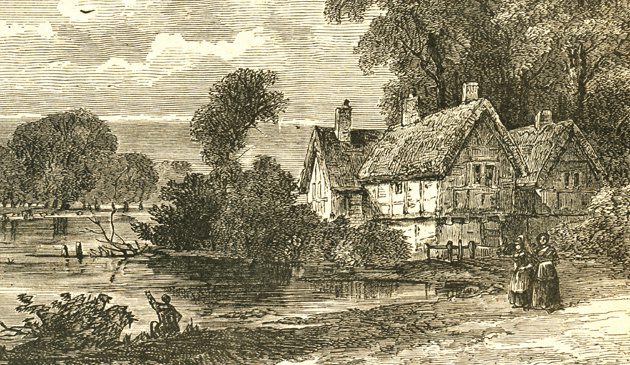London’s Restoration pleasure gardens

The water entrance to Cuper’s Gardens with its octagonal gazebo, across the Thames from the Savoy and Somerset House. From the entrance, known as Cuper’s Stairs, a short lane led to the pleasure gardens. The print dates from about 1730 and is taken from a painting by the maritime artist Samuel Scott.
Little is known of the older Spring Gardens. One theory is that was the garden of a mansion at Vauxhall owned by Sir Samuel Morland. Certainly, John Evelyn notes his visit to Sir Samuel’s house in the vicinity in 1681. In the early 18th century the old Spring Gardens, together with the house known as Spring Garden House, were in the possession of the vintners John and Hannah Burrows (or Burroughs) and were leased to expand New Spring Gardens, indicating that the older was adjacent to the new.
The name of ‘Spring Gardens’ at Vauxhall may have originally been taken from the older place at St. James’s Park, or from many of the streams and natural water features in the Vauxhall area. The French diplomat and diarist Balthasar de Monconys visited both the old and new venues at Vauxhall in 1663 and had the same opinion as Pepys, that the new gardens were an improvement on the old. He translated the name as ‘Jardin du Printemps’, meaning springtime.
New Spring Gardens spread over 11 acres and was actually little more than a mixed deciduous woodland, covered walks, and arbours, or alcoves, offering a private space, and huts serving food and drink. A Grand Walk of 700 feet ran east-west from the entrance, with the 500 feet Great Cross Walk on a north-south axis. A grid of lesser paths ran in parallel to each other. In the centre was the Grove, a meeting place of an acre.
One of the attractions was the choruses of songbirds. The gardens were illuminated at night and from early on the place was frequented by prostitutes, or “strumpets”, who masqueraded behind masks.
Pepys records at least 23 visits to New Spring Gardens in the six years covered by his diaries, 13 times between April and July 1668, and perhaps that demonstrates its popularity during the Reformation period. On each occasion he arrived by boat, sometimes during the evening after dark, often with his servant or other company, and occasionally with his wife. On occasions he visited as part of a group who ate, drank, sang and made merry. He notes that it is “cheap going thither, for a man may go to spend what he will, or nothing”, indicating that entry was free but visitors paid for food and refreshments. On his second visit he describes watching acrobats perform tricks. He visited alone in July 1665, while the Great Plague was raging, and found both London and the garden to be “so empty of anybody”. He next visited a year later when he was entertained by “a fellow that imitated all manner of birds, and dogs, and hogs, with his voice; which was mighty pleasant”. In May 1667 he could “hear the nightingale and other birds, and here fiddles, and there a harp, and here a jews trump [trumpet]”. Yet he was troubled to see “two pretty women” so harassed by “idle gentlemen” that they had to escape by boat, something that became a recurring theme.
New Spring Gardens was regularly mentioned in Restoration theatre, giving audiences a familiar setting for a drama. Mention is made of eating cheesecake, syllabubs, and strawberries, lobster, the wafer-thin ham for which the place became well-known, as well as other dishes. The standard beverages were beer, wine and rack-punch, the latter including rum, brandy, sugar and spices. The risqué reputation of the gardens was known to theatre-goers, with scenes of sexual intrigue, amour in the arbours, and of high-class courtesans.
There are various theories as to the original proprietor of New Spring Gardens but nothing as yet conclusive. In 1694 the gardens were offered for sale in the London Gazette. Enquiries were to be made to “Mrs. Elizabeth Plant at Fox-Hall near the Gardens”. We also know that in 1729 the lease on the property was held by the widow Mrs. Elizabeth Masters and in that year she sublet the enterprise for 30 years to Jonathan Tyers of Bermondsey. The lease agreement detailed various buildings, including a kitchen, bakehouse, milk-house, pastry room and cellars. The arbours were listed, with many of them having their own names.
In the 18th century New Spring Gardens was more generally known as Vauxhall Gardens. Under Tyers’s management it became the most popular place of entertainment in the whole of the country. It continued until the middle of the 19th century, almost 200 years after its opening. It is now a public open space.


